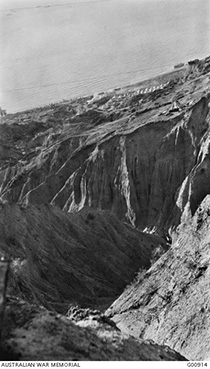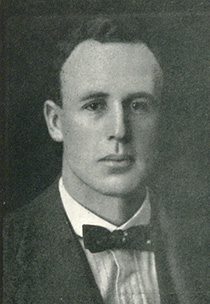
View of the head of Mule Valley and Walker's Ridge looking down to Anzac Cove, taken by Australia’s official war correspondent C.E.W. Bean in September 1915. Australian War Memorial G00914
War Service
On 14 August 1914, Northcroft enlisted with the Auckland Regiment of the New Zealand Mounted Rifles (NZMR), a unit in which had he had served as a territorial. Commanded by Lieutenant-Colonel Charles Mackesy, the Auckland Mounted Rifles Regiment (AMR) comprised three squadrons: the 3rd (Auckland) Squadron, of which Northcroft was a member, the 4th (Waikato) Squadron and the 11th (North Auckland) Squadron, a total strength of 26 officers, 523 other ranks and 608 horses.
After training at Epsom Camp and at Otahuhu, Northcroft sailed with the Main Convoy on 16 October 1914 aboard HMNZT Waimana or Star of India. The AMR’s horses were stabled in specially prepared areas of the ships. However, it was not an easy journey for the Convoy’s nearly 4000 horses, with three percent dying. Arriving in Egypt in early December, the Regiment travelled by train to Zeitoun Camp near Cairo where, once their horses had acclimatised, training began in earnest. Like their Australian counterparts, the Light Horse, the NZMR were not trained to fight on horseback, like traditional cavalry, but to ride into action, dismount and fight like ordinary infantry. Northcroft, who had enlisted as a Trooper, was promoted to Lance Corporal in February 1915.
 Auckland Mounted Regiment training camp at Otahuhu, Auckland, October 1914.Sir George Grey Special Collections, Auckland Libraries, AWNS-19150211-43-3.
Auckland Mounted Regiment training camp at Otahuhu, Auckland, October 1914.Sir George Grey Special Collections, Auckland Libraries, AWNS-19150211-43-3.
In early April 1915, when the Australian and New Zealand Infantry Division received orders to prepare for the invasion of Gallipoli, the NZMR and the Australian Light Horse brigades were told, much to their disappointment, that they were to remain in Egypt to defend the Suez Canal. However, in May they received orders to go to Gallipoli as much needed reinforcements. The mounted units were to fight as infantry, leaving their horses, farriers and some recently arrived reinforcements in Egypt. On 9 May 1915, the regiment left Alexandria aboard HMT Grantully Castle and arrived at Anzac Cove on 12 May.
Landing at Anzac Cove in high spirits, the men of the AMR encountered a ‘few worn, beaded men, whose sunken eyes and deeply-lined faces told of the ordeal they had been through’. Their cheerful greetings were met with monosyllabic responses from these ‘veterans’ who had landed at Gallipoli only weeks before. The AMR was assigned to Walker’s Ridge, an important strategic position high on the ridge which overlooked Anzac Cove. As they worked to extend and deepen the system of trenches begun by the Nelson and Deal Battalions of the Royal Marine Light Infantry who had previously occupied the ridge, the men quickly discovered that ‘to be able to dig is one of the first qualifications of a soldier’.
At midnight on the night of 18/19 May, the AMR’s position came under heavy fire. At 3.30am ‘the Turkish fire slackened, and then after an ominous silence, the enemy sprang to the attack. Cries of “Allah, Allah, Allah” from thousands of throats rent the air.’ Northcroft’s death in the fierce fighting that followed is described by Trooper Charles F. Jones: ‘Harry Northcroft was shot dead only a yard from me, also Jim Thompson. A German got round the end of our trench, shot Northcroft dead, and just missed me by a whisper, the bullet getting old Jim through both temples.’
By 4.30am, the AMR had repulsed the attack on their position but 22 of their men were dead and another 27 wounded. The bodies of the fallen were buried nearby and the position of each grave carefully recorded by Colonel Mackesy, who sent a copy of his report to Mr Christopher James Parr, the Mayor of Auckland. In the accompanying letter Mackesy wrote that the attack on Walker’s ridge had been the AMR’s baptism of fire but that ‘they came out pure gold’ and ‘No commander ever had a finer and braver lot of gallant young gentlemen to lead into action’.






